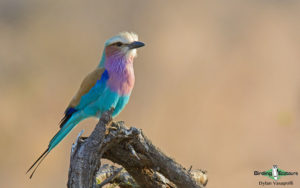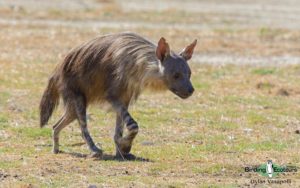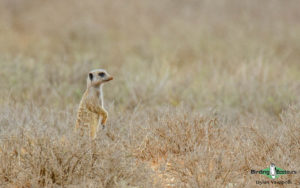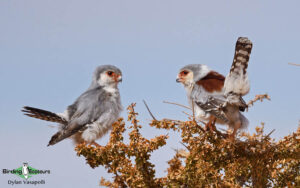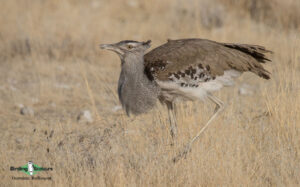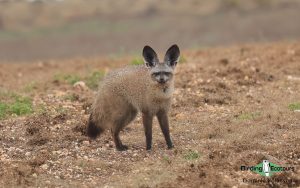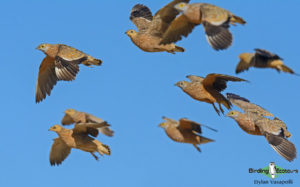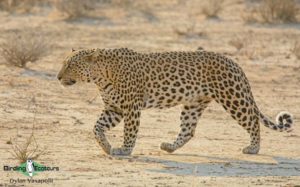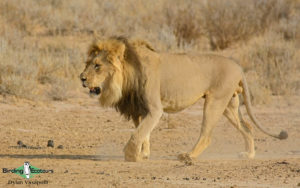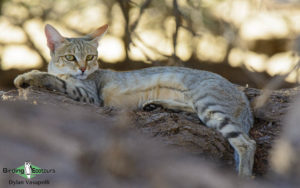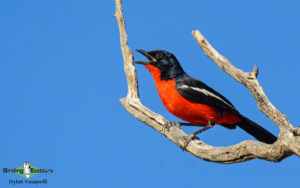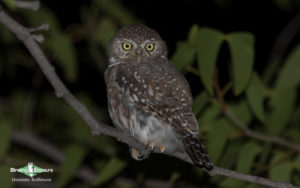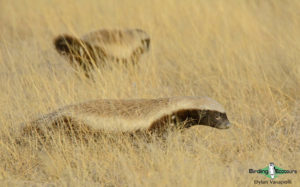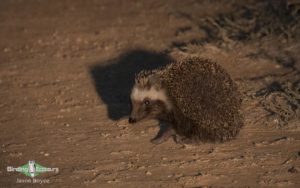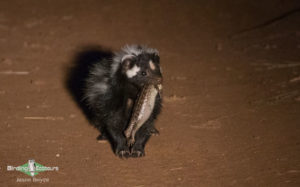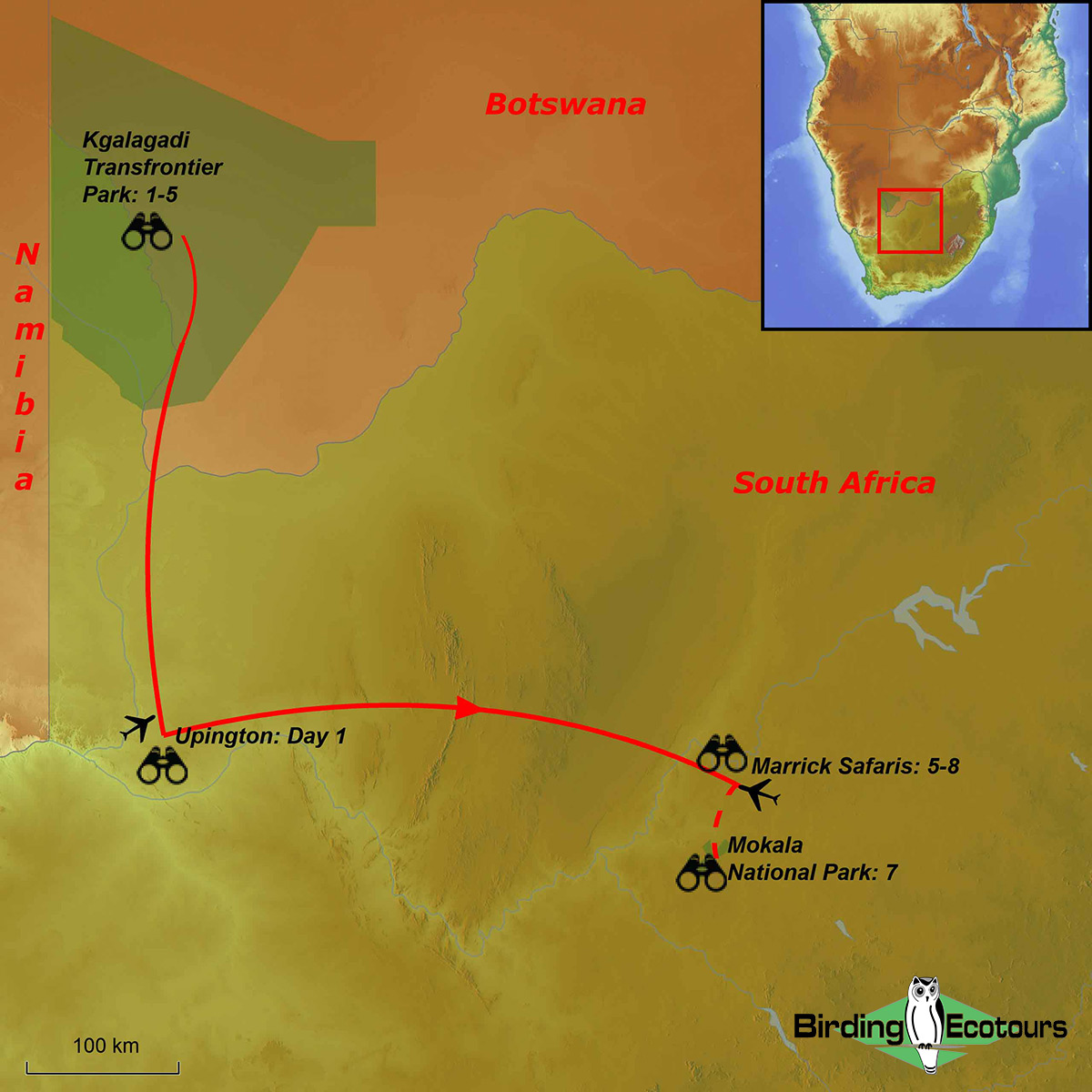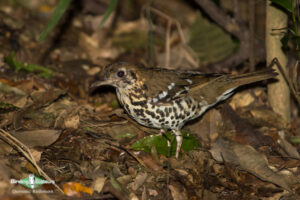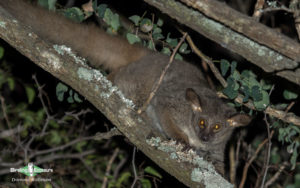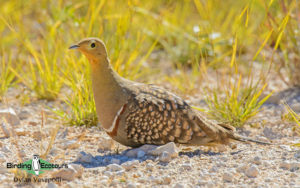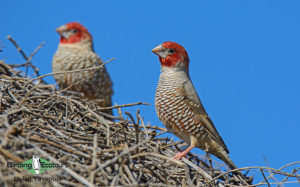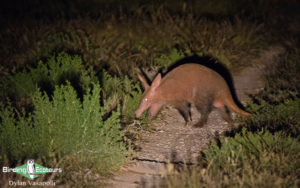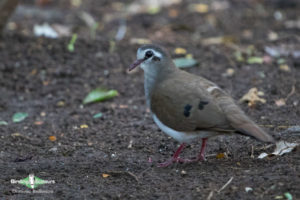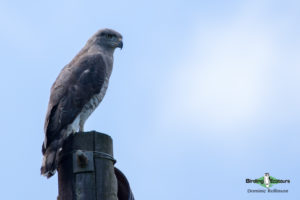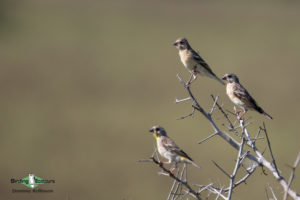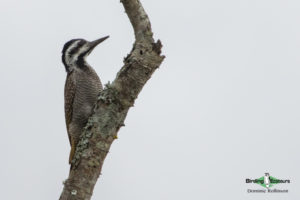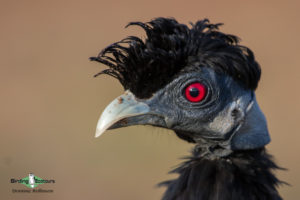Mammal and Birding Tour South Africa: Aardvark and Other Unusual Denizens of the Kalahari
Go to: South Africa birding tours | Birding tours in Africa | Mammal tours | All our birding tours
Mammal and Birding Tour South Africa: Aardvark and Other Unusual Denizens of the Kalahari
September 2026
The vast Kalahari area is semi-desert, where some very tough African mammals can be found relatively easily. Moreover, it has a lot of mammals (notably smaller ones) that are only very rarely seen anywhere else and most certainly are not found on your typical Serengeti or Kruger safari. We invite you on a spectacular African experience that you will not forget in a hurry.
The bizarre Aardvark will hopefully be found on this trip.
Itinerary (8 days/7 nights)
Days 1 – 4. Kgalagadi Transfrontier Park
Today we transfer from Upington to the Kgalagadi Transfrontier Park (3 hours), which encompasses three countries; South Africa, Namibia, and Botswana. Over the next few days, we will spend time in one of South Africa’s most popular parks, where bird and particularly mammal sightings are normally exceptional. Gemsbok, Springbok, Common Eland, and Red Hartebeest can be seen in the open areas while African Elephant roams the dry riverbeds, searching for their next water source. The Kgalagadi Transfrontier Park is particularly well known for its big cat sightings, and here we can hope to find black-maned Lion, Leopard, and Cheetah, as well as some of the smaller, lesser-known felines such as African Wild Cat and Caracal. Other predators to keep an eye out for include Common (Small-spotted) Genet, Cape and Bat-eared Foxes, Black-backed Jackal, Brown Hyaena, and Honey Badger. Smaller mammals are also in abundance in the park and include small groups of Meerkats and South African Ground Squirrels as well as Yellow Mongoose, Cape Hare, and Chacma Baboon.
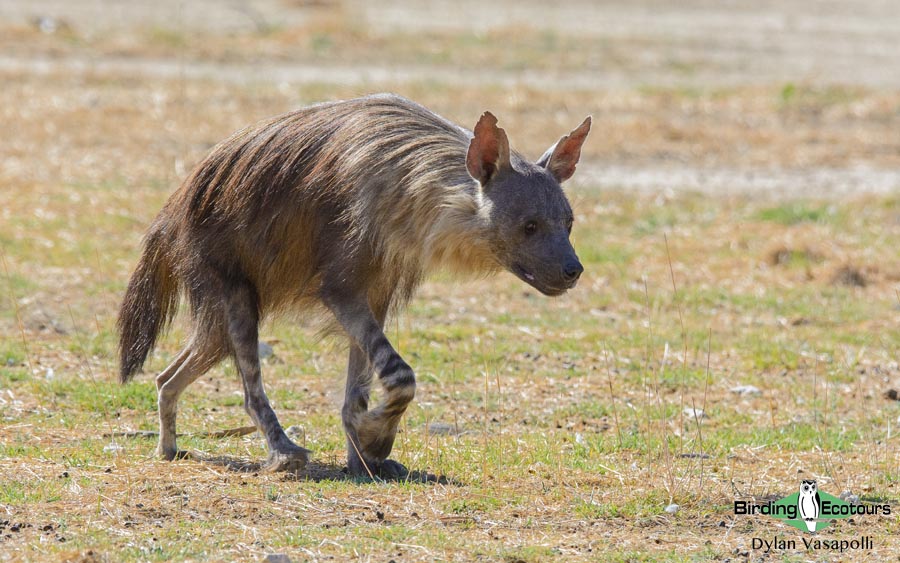
Birding in the park is also top-notch, with raptors being particularly abundant and obvious. On our drives through the park we should encounter Lappet-faced Vulture, Pale Chanting and Gabar Goshawks, Greater Kestrel, Red-necked Falcon, Bateleur, Tawny and Martial Eagles, Brown and Black-chested Snake Eagles, Lanner Falcon, and the diminutive Pygmy Falcon, which nests exclusively in massive Sociable Weaver nests. In the more open plains, we should find Kori Bustard, Northern Black Korhaan, Burchell’s and Namaqua Sandgrouse, Pink-billed and Eastern Clapper Larks, Ant-eating Chat, and Grey-backed Sparrow-Lark. The dry river beds are a magnet for birdlife, and we will search these areas for Verreaux’s Eagle-Owl, Crimson-breasted Shrike, Kalahari Scrub Robin, Swallow-tailed Bee-eater, Marico Flycatcher, and Ashy Tit. The nocturnal life in the camps can also be impressive, with Western Barn Owl, Spotted Eagle-Owl, Southern White-faced Owl, and African Scops Owl all present as well as the tiny Pearl-spotted Owlet, which is also active during the day. We will also join a night drive and three game drives in open-top safari vehicles during our time in the park, which should increase our chances of finding some of the rarer mammal species.
Overnight: Kgalagadi Lodge (just outside the Kgalagadi Transfrontier Park)
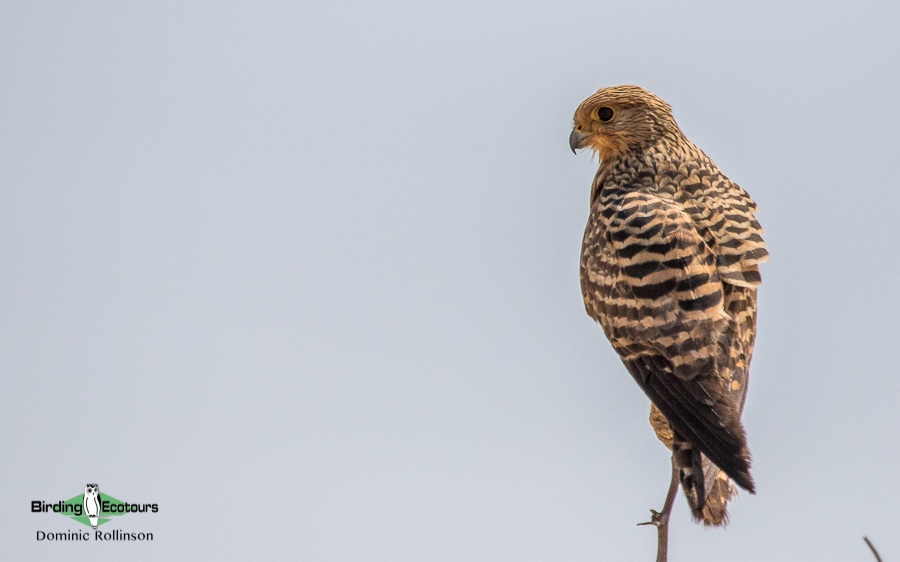
Day 5. Transfer to Kimberley
After an early breakfast we will take the long (6.5 hours) drive to Kimberley, more specifically Marrick Safari, a large game farm, which will be our base for the next few days. We will join two night drives during our three-night stay here. On these night drives we will look for Aardvark, which has burrows quite close to the lodge and as a result has become fairly tame toward humans, relatively speaking. Black-footed Cat is also a major target here. These small cats are extremely rare; however, Marrick must rank as one of the best places to see them. We might also encounter Bat-eared Fox, Aardwolf, Southern African Hedgehog, Cape Porcupine, and Spring Hare.
Overnight: Marrick Safaris
Day 6. Kimberley
After breakfast we head out to look for some more of our target species. Black Wildebeest, rated by some as the most stupid of all antelopes (due to their inquisitive nature), will be found with relative ease, along with Giraffe, Common Eland and Gemsbok, while Caracal will require some luck! Once again, we will spend some time on foot during the day, looking for small mammals, reptiles, and the likes. Birding can also be particularly rewarding, with Blue Crane often breeding on the farm and Double-banded Courser sometimes common. Other birds to see around the property include Secretarybird, Bradfield’s Swift, Pink-billed, Red-capped, Fawn-colored, and Spike-heeled Larks, Golden-tailed Woodpecker, Cape Penduline Tit, Quailfinch, Black-faced Waxbill, and many Lark-like Buntings. After dinner we may go for our other night drive.
Overnight: Marrick Safaris
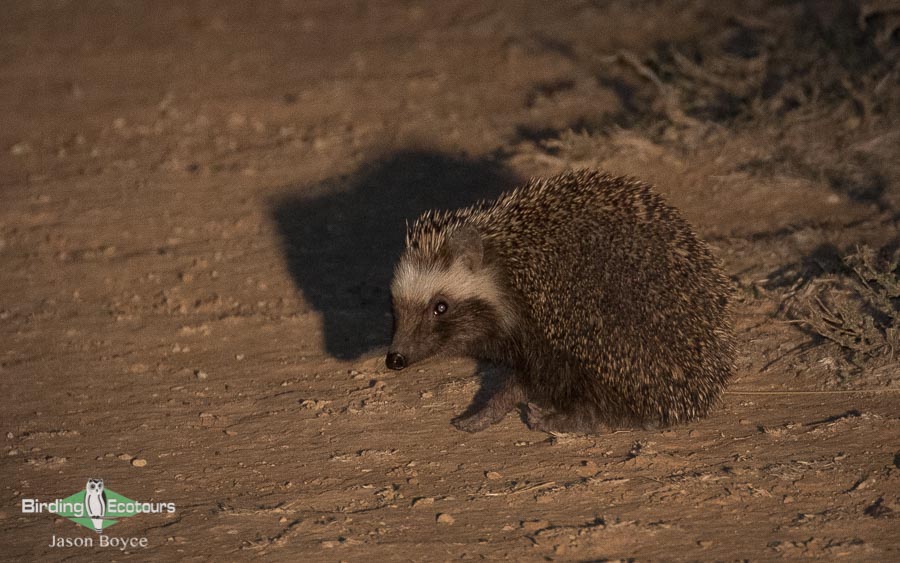
Day 7. Kimberley
This will be our last full day in the Kimberley area, which we’ll spend for the most part in nearby Mokala National Park. This is a recently proclaimed South African national park, a truly splendid one, which holds, among many others, not only a large herd of Roan Antelope but also Sable Antelope, Kudu, Black Wildebeest, Giraffe, Tsessebe, Steenbok, and Meerkat (Suricate). Birds to look for around the park include Short-toed Rock Thrush, Red-crested Korhaan, Yellow Canary, Red-headed Finch, Buffy and Nicholson’s Pipits, Long-tailed Paradise Whydah, Mountain Wheatear, Striped Kingfisher, and Shaft-tailed Whydah. We might also briefly visit the Kimberley “Big Hole” for those that might want to catch a quick glimpse of the deepest human-made hole in the world.
Overnight: Marrick Safaris
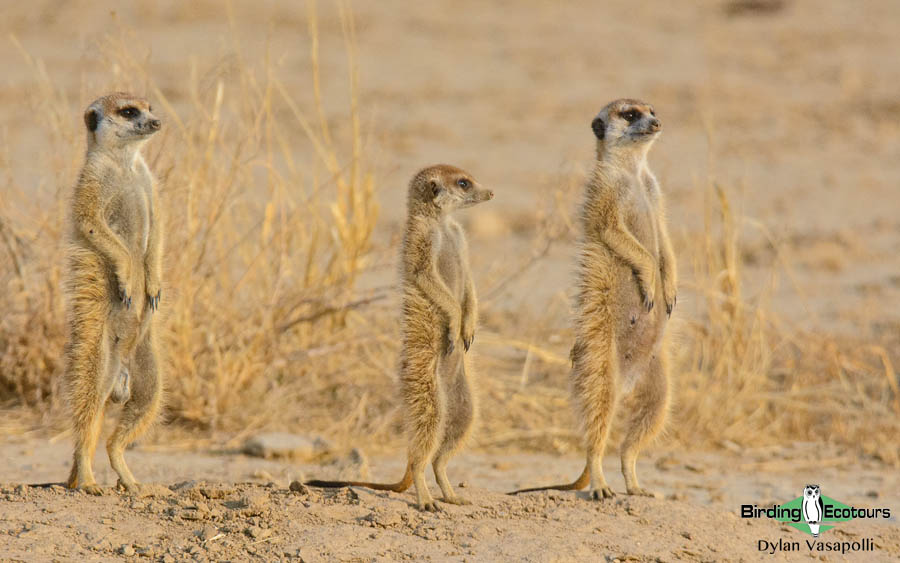
Day 8. Departure
After some final mammal- and bird-viewing we make a short (half-an-hour) drive to Kimberley airport, where the tour concludes.
Please note that the itinerary cannot be guaranteed as it is only a rough guide and can be changed (usually slightly) due to factors such as availability of accommodation, updated information on the state of accommodation, roads, or birding sites, the discretion of the guides and other factors.
Download ItineraryKalahari, Drakensberg, and Zululand Trip Report, April 2019
2 – 17 APRIL 2019
By Dylan Vasapolli and Dominic Rollinson
DOWNLOAD TRIP REPORT
We had fantastic views of Spotted Ground Thrush in Eshowe.
Overview
This 16-day tour combined our Kalahari Mammal and Birding Tour with our Drakensberg and Zululand Mammal and Birding Tour. It was designed to include many diverse South African ecosystems from the seemingly desolate landscape of the Kalahari Desert in the west to the lush and biodiverse forests of KwaZulu-Natal in the east. As we were covering a large portion of South Africa, it did mean a few long drives; however, we generally had at least two nights at most destinations, which meant we could explore the area and its wildlife before moving on.
A total of 358 bird species were recorded, with some of the birding highlights going to African Pygmy Goose, Crested Guineafowl, Natal Spurfowl, Southern Bald Ibis, Bearded and Cape Vultures, Southern Banded Snake Eagle, Kori Bustard, Northern Black Korhaan, Grey Crowned, Wattled, and Blue Cranes, Black-winged and Senegal Lapwings, Double-banded Courser, Namaqua Sandgrouse, Livingstone’s and Knysna Turacos, White-backed Mousebird, Mangrove Kingfisher, Green and Acacia Pied Barbet, Scaly-throated Honeyguide, Ground Woodpecker, Pygmy Falcon, Woodward’s Batis, Gorgeous Bushshrike, Blue-mantled Crested Flycatcher, Cape Penduline Tit, Spike-heeled, Eastern Clapper, Fawn-colored, and Pink-billed Larks, Cape Grassbird, Karoo and Drakensberg Prinias, Rudd’s Apalis, Rufous-eared Warbler, Bush Blackcap, Orange River White-eye, Spotted Ground Thrush, Bearded and Brown Scrub Robins, Chorister Robin-Chat, Cape Rock Thrush, Buff-streaked Chat, Greater Double-collared Sunbird, Eastern Golden Weaver, Green and Pink-throated Twinspot, Grey Waxbill, Short-tailed Pipit, and Lemon-breasted Canary.
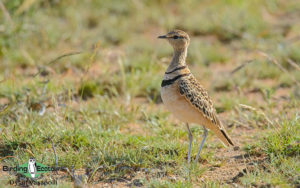
We also came across a number of rarely seen and charismatic African mammal species. Our trip list was an impressive 49 species and included the likes of Samango Monkey, Thick-tailed Greater Galago, South Africana Ground and Red Bush Squirrels, Springhare, Cape Porcupine, Bat-eared Fox, Meerkat (Suricate), Aardwolf, Aardvark, African Elephant, Roan Antelope, Sable Antelope, Gemsbok, Tsessebe, Natal Red and Blue Duikers, and Mountain Reedbuck.
Thick-tailed Greater Galago came to visit us at Mkhuze Game Reserve.
Detailed Report
Day 1, 2nd April 2019. Upington to Witsand Nature Reserve
After collecting clients from Upington Airport we picked up the last of our supplies needed for the next few days in the heart of the Kalahari, at Witsand Nature Reserve, and began the drive. With a lunch stop en route we made good time and were soon birding on the roads leading to the reserve. Virtually our first bird was a glorious Pygmy Falcon perched up on a roadside wire. Continuing further we also picked up Pale Chanting Goshawk, Red-crested and many Northern Black Korhaans, Chat Flycatcher, Ant-eating Chat, Scaly-feathered Weaver (Finch), and Lesser Grey Shrike. We eventually arrived at the reserve, and after a little delay in the check-in process we quickly unloaded our gear and set off on a late-afternoon walk. There was still a bit of activity around, and we enjoyed some excellent birds. Some of the highlights were Pririt Batis, Chestnut-vented Warbler (Tit-babbler), Kalahari Scrub Robin, Cape Starling, Ashy Tit, Long-billed Crombec, White-browed Sparrow-Weaver, Southern Yellow-billed Hornbill, Red-eyed Bulbul, and Black-chested Prinia. We also picked up our first mammals of the trip, namely South African Ground Squirrel, Yellow Mongoose, Springbok, Common Duiker, Greater Kudu, and after dark a friendly Common Genet.
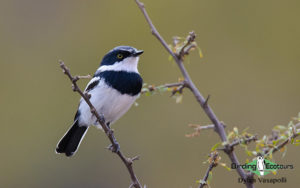
Day 2, 3rd April 2019. Witsand Nature Reserve
With a full day in store for us at Witsand we were up at dawn for a morning walk. We had some wind to contend with, which slowed things down a bit, but were still able to eke out a number of new species, combined with many of those we had seen yesterday. Acacia Pied Barbets and White-browed Sparrow-Weavers showed well early on before we fortuitously stumbled onto a Pearl-spotted Owlet, which, although remaining shy, gave us great views! We were also able to add Violet-eared Waxbill, Marico Sunbird, Marico Flycatcher, Brubru, and Fork-tailed Drongo. We slowly made our way to the hide, timing it for sandgrouse coming in to drink, but despite waiting a while we had to walk away without any sandgrouse, and, somewhat surprisingly, only a few birds were present around the water, namely Yellow and Black-throated Canaries, Dusky Sunbird, and Namaqua Dove.
Following a good breakfast we took a drive to see the roaring dunes, and, although it was getting warm and the wind was steadily picking up as the day progressed, we enjoyed a few new birds. Dainty Fawn-colored Larks scampered about the grassy regions while Brown-crowned Tchagra kept to the thicker trees and a superb pair of Namaqua Sandgrouse paused next to the road, giving us excellent and prolonged views. Black-backed Jackal, Gemsbok, and Leopard Tortoise were noted on the way as well. We made the climb up to the top of the dunes but were nearly blown away, and so we made our way back down, covered in sand. Another turn past the hide to see what was around during the midday period was also a little quiet, and we were only able to add Red-headed Finch and Serrated Tent Tortoise.
Following an afternoon siesta, just as we were gearing up to head out for the afternoon, the sky darkened and an impressive thunderstorm put our plans on hold. Fortunately the storm abated soon enough for us to still head out for the last portion of the afternoon, and although we were witness to some impressive skies the birding was rather quiet, with the only notable sighting going to a showy Crimson-breasted Shrike. A number of Scrub Hares were seen in the evening at camp and the friendly Common Genet along with a Cape (Small) Gray Mongoose around our chalet.
Namaqua Sandgrouse posed beautifully for us at Witsand Nature Reserve.
Day 3, 4th April 2019. Witsand Nature Reserve
We had another full day at our disposal at Witsand Nature Reserve and awoke to a fine, clear day. We started with an early-morning trip to the bird hide, where we spent a while waiting for birds to come in, but like yesterday it was awfully quiet. A similar collection of species did finally appear, namely Yellow Canary, Namaqua Dove, Acacia Pied Barbet, Red-headed Finch, Familiar Chat, Cape Wagtail, Red-faced Mousebird, Southern Yellow-billed Hornbill, Red-eyed Bulbul, White-browed Sparrow-Weaver, Fiscal Flycatcher, Greater Striped Swallow, Ashy Tit, Southern Masked Weaver, Namaqua Sandgrouse (heard only), and Lark-like Bunting, while the highlight was a pair of glorious Green-winged Pytilia that showed for a little while before they moved out of sight.
A quick walk around the Acacia thickets at the chalets delivered a feisty Fairy Flycatcher that never stopped moving along with a showy Common Scimitarbill, Black-throated Canary, Pririt Batis, Crowned Lapwing, Rock Martin, and Kalahari Scrub Robin. We took a break over the midday period before resuming birding later in the afternoon. The afternoon stint was rather quiet again, with a bit of wind and clouds gathering, although we were finally able to hear the ‘roaring dunes’ that Witsand is known for. Some of the birds seen in the afternoon included Pygmy Falcon, White-backed Mousebird, Sabota and Fawn-colored Larks, Kalahari Scrub Robin, Sociable Weaver, Southern Yellow-billed Hornbill, and a few small groups of Namaqua Sandgrouse, among a few others. A late-afternoon walk around the chalets gave us a few new species, namely Blacksmith Lapwing, Crested Barbet, and Cardinal Woodpecker. We had a similar collection of mammals today as on the last few days. A wonderful sunset and a tasty dinner rounded up our lovely stay at Witsand Nature Reserve.
Red-headed Finch were fairly common on the Kalahari leg of this tour.
Day 4, 5th April 2019. Witsand Nature Reserve to Marrick Safaris
We awoke to cold, windy morning and, with a grey sky looming overhead, decided to rather have an early breakfast and transit to Kimberley and Marrick Safaris after it. Stops along the route gave us a group of the spectacular Swallow-tailed Bee-eaters and a large Black-breasted Snake Eagle. We arrived in Kimberley in good time and made our way to the Big Hole for a quick visit. Whilst admiring the view over the depression we kept our eyes alert for birds and enjoyed a number of species, namely Orange River White-eye, White-backed Mousebird, Cinnamon-breasted Bunting, Cape Sparrow, Brown-throated Martin, and eye-level views of Booted Eagle.
Following lunch in town we made our way to Marrick Safaris, checked in, and got settled before heading out on an afternoon walk. This walk was excellent, and we raked up many fine species, the highlights being a stately Secretarybird perched in the road, a tiny Cape Penduline Tit, and the gaudy Black-faced Waxbill, Golden-breasted Bunting, and Shaft-tailed Whydah. Among others we also enjoyed African Hoopoe, Wattled Starling, Rock Kestrel, Three-banded Plover, Lark-like Bunting, numbers of Grey-backed Sparrow-Larks, Red-billed Firefinch, Quailfinch, Golden-tailed Woodpecker, Lesser Grey Shrike, Diederik Cuckoo, Desert Cisticola, Blue Crane, White Stork, Red-breasted Swallow, and a host of swifts comprising Alpine, Bradfield’s, and Little Swifts. A truly great afternoon, and a fine welcome to Marrick Safaris!
Day 5, 6th April 2019. Mokala National Park
We set off at dawn, bound for the nearby Mokala National Park, where we would spend the day. We arrived in good time and began birding the entrance road and the outskirts of the reserve. Some of the species seen included a fine pair of Pale Chanting Goshawks, Rufous-eared Warbler, Ant-eating Chat, and Buffy Pipit, along with Lark-like Buntings that seemed to have moved into this area en masse (as there were hundreds almost everywhere you looked). After checking into the reserve and enjoying breakfast we set off on our first drive. With the sun already quite high in the sky the activity was a bit on the slow side, but we were able to add a brief Long-tailed Paradise Whydah, Mountain Wheatear, Common Ostrich, Yellow-bellied Eremomela, White-rumped Swift, Long-billed and Buffy Pipits, and Striped Kingfisher, while also enjoying a number of species we had already seen like Sociable Weaver, Yellow Canary, Red-headed Finch, Booted Eagle, Southern Yellow-billed Hornbill, Swallow-tailed Bee-eater, Rock Kestrel, and Shaft-tailed Whydah, as well as a few of the tiny Pygmy Falcons – always a treat to see.
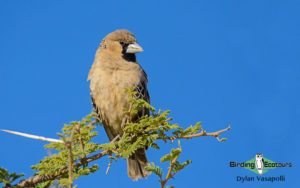
We also had seen a wide selection of the reserve’s mammals during our drives, including the scarce Tsessebe as well as Sable Antelope, Red Hartebeest, Blue Wildebeest, Plains Zebra, Giraffe, Steenbok, Common Warthog, Impala, and some of the mammals we had already seen, including Gemsbok, Springbok, and Vervet Monkey. Sadly a part of the reserve we wanted to access was flooded, which meant no access was allowed, so we had to change our plans around slightly as we went off in search of our lunch spot. The midday period was rather quiet, with our only sightings going to another few Pygmy Falcons (surprisingly good numbers of these fierce-looking raptors were around) and Red-crested Korhaan. We took a short break after lunch before setting off bound for the entrance gate and eventually Marrick. After much searching we eventually located one of our main targets, Short-toed Rock Thrush, at the last possible site and enjoyed good views before it moved out of sight, with not too many other birds around. However, a number of mammals were active in the late afternoon, and we enjoyed great views of many of the species we had encountered during the day. One of our main targets, Meerkat (or Suricate) had eluded us so far, and quite literally just as we were about to leave the reserve we ran into a small family group next to the road, but they remained a bit shy as they disappeared into the grass, bound for their den. We notched up Greater and Lesser Kestrels on our way back.
The day was not done yet, however, as the main event was still to follow – our night drive. We set off after dinner, and the next few hours went by in a relative blur as we enjoyed the excellent night-life of Marrick. We encountered many pairs of Bat-eared Foxes, no less than four Aardwolves, two great and prolonged sightings of Aardvark, and a family of four Cape Porcupines among a host of more common mammals like Springhare and Scrub and Cape Hares. It wasn’t all about the mammals, though, as we also enjoyed a number of Double-banded Coursers, Red-capped Lark, Spotted Thick-knee, and Rufous-cheeked Nightjar during the course of the night. A fantastic end to a great day!
We had prolonged views of the bizarreAardvark at Marrick Safaris.
Day 6, 7th April 2019. Full day at Marrick Safaris
We had a full day at Marrick and began things with a morning drive through the dry grasslands. We started well with two flushed Common Buttonquails, which gave us great views. The cold wind blowing didn’t keep us outside the vehicle for too long, but we made stops for Cloud Cisticola, Eastern Clapper Lark, a pair of Secretarybirds, and a large group of Meerkats (Suricates), which were sunbathing. A little while later we found a second family of Meerkats, much closer time, and we spent some time watching them. As the temperature began warming up we noted an increase in lark activity, and we soon enjoyed views of the sought-after Pink-billed Lark along with Spike-heeled, Red-capped, and Fawn-colored Larks and good numbers of Grey-backed Sparrow-Larks. We also ran into a few groups of Double-banded Coursers, which are always a joy to see, and it was good seeing them in the day time as well. We rounded the morning drive off well with the same pair of Secretarybirds we had seen earlier, much closer to us this time, and we also noted an immature one foraging not too far from them, which we had missed earlier.
We enjoyed a good breakfast to celebrate our fine morning before we set off for the hide, where we’d spend some time over the midday period. There was a lot of activity at the hide, with birds regularly coming and going, and over the short time we spent here we saw Green-winged Pytilia, Violet-eared and Black-faced Waxbills, Ashy Tit, Lark-like and Cinnamon-breasted Buntings, large numbers of Red-billed Queleas, Yellow and Black-throated Canaries, Red-headed Finch, and Long-tailed Paradise Whydah. We took a break until the mid-afternoon, when we resumed our birding once more.
Our afternoon drive started well with a Western Barn Owl at a day roost before we searched the usually dry but now shallowly inundated pan, notching up a number of scarcer Northern Cape wetland birds. There were small groups of Red-billed Teals and South African Shelducks located throughout the pan, and careful scanning revealed Spur-winged and Egyptian Geese, Cape Teal, and Southern Pochard, along with Glossy and African Sacred Ibis. As we walked around we also picked up a group of African Spoonbills, many Black-headed Herons, and White Stork, while a pair of Blue Cranes strolled around the edges. A closer search of the pan periphery gave us Ruff, Common Greenshank, African Snipe, Quailfinch, Pink-billed Lark, and large numbers of colorful Yellow-crowned and Southern Red Bishops. The plains around the pan held more Double-banded Coursers, Capped Wheatear, Spike-heeled Lark, and Grey-backed Sparrow-Lark, along with a small family of Cape Penduline Tits, before we ran out of daylight and called it a day. There were similar mammals present today as we had seen regularly over the last few days, with the highlight being the scarce Roan Antelope.
Day 7, 8th April 2019. Marrick Safaris to Giant’s Castle, Drakensberg
With a long drive ahead of us to Giant’s Castle in the southern Drakensberg we set off from Kimberly after an early breakfast, bound for Golden Gate Highlands National Park, which would be our main port of call en route to Giant’s Castle. There was a general paucity of birds along the route, with the only notable exception being Kori Bustard, and as a result we made good time, arriving at this scenic park at lunch time. Although we didn’t have much time available to explore the park we were still able to enjoy a few species, such as Jackal Buzzard, White-necked Raven, Drakensberg Prinia, Rock Kestrel, Mountain Wheatear, Pied and Red-winged Starlings, and African Stonechat. All too soon we had to leave this spectacular park, bound for Giant’s Castle, and the drive took up the remaining portion of the day, with us arriving just as it started to get dark. Dom Rollinson joined us here and would be guiding the trip for the KwaZulu-Natal leg.
Day 8, 9th April 2019. Giant’s Castle, Drakensberg
We were up early today and managed a couple of hours of productive birding before breakfast. With the huge change in habitat from the first leg of the trip many of the birds we were seeing were new. Highlights in the montane grassland and forest patches around Giant’s Castle included Cape Batis, Black Saw-wing, Cape Grassbird, Drakensberg Prinia, Yellow-throated Woodland Warbler, Lazy Cisticola, Cape White-eye, Cape Rock Thrush, Buff-streaked Chat. and Ground Woodpecker. After a hearty breakfast we bade Dylan farewell and then had another walk around the camp. The star bird on this walk was certainly Bush Blackcap, which eventually showed well for us. Other good birds included Greater Double-collared Sunbird, Olive Woodpecker, Southern Boubou, Black-backed Puffback, Bar-throated Apalis, and African Stonechat.
In the afternoon we went on a couple of drives out of camp to explore a little farther afield and had more fantastic birding. Bearded and Cape Vultures were seen overhead with Red-necked Spurfowl, Gurney’s Sugarbird, Ant-eating and Buff-streaked Chats, African Firefinch, Yellow Bishop, and Red-collared Widowbirds seen in the nearby grassland. The most unexpected sighting was that of a Lark-like Bunting, an extremely rare species in the province of KwaZulu-Natal!
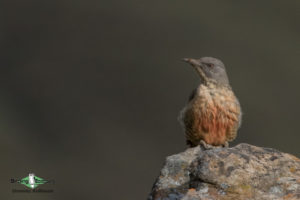
Day 9, 10th April 2019. Giant’s Castle to Eshowe
We had a fairly brief birding session before breakfast and managed to add Bokmakierie, African Black Swift, Banded Martin, and Wailing and Levaillant’s Cisticolas. After breakfast we left Giant’s Castle and headed to Eshowe, where we would be based for the next two nights. We had some great birding along the drive, and a few stops in the Natal Midlands produced Wattled Crane, Southern Bald Ibis, Cape Longclaw, Quailfinch, Jackal Buzzard, Black-winged Kite, and Lanner Falcon. A stop at a small dam near Karkloof yielded Grey Crowned Crane, Giant Kingfisher, Cape Shoveler, South African Shelduck, and White-backed Duck, with Black-winged Lapwing in the nearby grasslands.
At a small forest patch not far from Eshowe we found a single Knysna Turaco (right on the edge of its range here) along with Collared Sunbird and Red-fronted Tinkerbird, as well as a Dusky Indigobird in the grassland on the edge of the forest. After checking into our accommodation in Eshowe we did some birding on the edge of town; unfortunately the weather had closed in and it was not too productive. We did, however, come across White-bellied Sunbird and Trumpeter Hornbill.
Day 10, 11th April 2019. Ongoye Forest and Eshowe birding
Green Barbet was top of the agenda today, which meant a predawn departure from Eshowe to make it to the nearby Ongoye Forest just after sunrise. This is the only forest in which the southern subspecies (S. o. woodwardi) of Green Barbet occurs, and it did not take too long until its choc-choc call betrayed its presence. Other birds seen in the forest included Grey Cuckooshrike, Black-bellied Starling, White-eared Barbet, Green-backed Camaroptera, Blue-mantled Crested Flycatcher, Lemon Dove, Black Sparrowhawk, African Olive Pigeon, Purple-crested Turaco, Yellow-rumped Tinkerbird, Olive Sunbird, and Samango Monkey. When things got slow in the forest we decided to take a drive into the beautiful grasslands surrounding the forest and got lucky by flushing a single Short-tailed Pipit, while also adding Yellow-throated Longclaw as well as Zitting and Croaking Cisticolas.
We then decided to bird the bushveld in the valley below, in particular the riparian vegetation, which again proved productive with Burchell’s Coucal, Black-collared and Crested Barbets, Orange-breasted Bushshrike, African Paradise Flycatcher, Southern Black Tit, Sombre Greenbul, Arrow-marked Babbler, Southern Black Flycatcher, and Spectacled Weaver all showing themselves.
We headed back to Eshowe and had a quick bite to eat before heading out again later in the afternoon, when we birded at Dlinza Forest, right in the middle of Eshowe. Birding was fairly slow; however, we did find Tambourine Dove, Trumpeter Hornbill, and Square-tailed Drongo and had very brief views of our main target, Spotted Ground Thrush. After another great meal we decided to turn in for the evening.
This female Tambourine Dove was seen at the hide at Dlinza Forest.
Day 11, 12th April 2019. Eshowe to St Lucia
We were up before sunrise again this morning and headed to Dlinza Forest to try to improve our sighting of Spotted Ground Thrush and find any other forest species we were still missing. At the bird hide on the edge of the forest we had great views of a single female Green Twinspot as it came down to feed on seed laid out for them. A Blue Duiker also arrived to inspect the bird bath, as did a very obliging Chorister Robin-Chat. Afterwards we headed deeper into the forest, where a certain high-pitched call betrayed the presence of a juvenile Spotted Ground Thrush that was being fed by one of its parents. We watched this interaction for a good 20 minutes and managed some great pictures. We then spent some time tracking down a few noisy Terrestrial Brownbuls, which eventually showed themselves.
After a full English breakfast we left Eshowe and headed toward the coast at St Lucia. We did, however, have a couple of birding stops en route. First we stopped at a small farm dam, where we quickly found African Pygmy Goose as well as White-backed Duck and White-faced Whistling Duck, Black Crake, and a Rufous-winged Cisticola in the surrounding cane fields. Next we headed to the coastal forests of Mtunzini, where we were targeting Mangrove Kingfisher. The kingfisher did not take long to locate; however, we did not have any luck with Palm-nut Vulture, which breed in the area.
We arrived in the coastal village of St Lucia, and after checking into our accommodation we headed out for the afternoon’s birding. We started with the Igwala Gwala Forest Trail, which takes you through some beautiful costal forest with some fantastic birding. Highlights here included Livingstone’s Turaco, Golden-tailed and Cardinal Woodpeckers, Square-tailed Drongo, Ashy Flycatcher, and Red Bush Squirrel. We then headed to the estuary to try to add a few waterbirds; unfortunately the water levels were about the highest I had ever seen, and as a result there was not a great deal around. We did, however, add Water Thick-knee, Pink-backed Pelican, Caspian Tern, a few common waders, and a vagrant Eurasian Oystercatcher, which had been here for the last few months.
Day 12, 13th April 2019. Full day’s birding around St Lucia
The morning started with another walk in St Lucia’s coastal forest, where we were still looking for a few specials. Thankfully it did not take too long until Brown Scrub Robin, Woodward’s Batis, and Rudd’s Apalis showed themselves, along with Yellow-bellied Greenbul, Scaly-throated Honeyguide, Crowned Hornbill, Yellow-breasted Apalis, Grey Sunbird, and Crested Guineafowl, with African Goshawk and Blue-cheeked Bee-eaters flying overhead. A troop of Banded Mongooses were seen as they ran across the path in front of us.
The rest of the day was spent birding around St Lucia village and along the eastern shores of Lake St Lucia in the iSimangaliso Wetland Park, where we easily found our target, Southern Banded Snake Eagle, as well as fleeting glimpses of Grey Waxbill, with Green Malkoha heard calling incessantly, but frustratingly it would not show itself. Other good birds that were seen in iSimangaliso Wetland Park included Black-chested Snake Eagle, Long-crested Eagle, Eastern Golden Weaver, and Brimstone Canary.
Southern Banded Snake-Eagle was the highlight around St Lucia.
Day 13, 14th April 2019. St Lucia to Mkhuze Game Reserve
We had another quick walk around the forest in St Lucia before breakfast., during which we saw a similar collection of birds as yesterday; however, we managed great views of a confiding Grey Waxbill before it was time to pack and be on our way north. We drove along the western edge of Lake St Lucia today and managed to find a few late Amur Falcons feeding in the coastal grassland. We enjoyed our lunch in a shady spot in some Acacia woodland near Hluhluwe town and suddenly were seriously distracted by a nearby bird party, which resulted in a frenetic 45 minutes of birding. The bird party held Common Scimitarbill, Golden-tailed Woodpecker, Chinspot Batis, Orange-breasted Bushshrike, Black Cuckooshrike, Southern Black Tit, Willow Warbler, Burnt-necked Eremomela, Grey Tit-Flycatcher, Scarlet-chested Sunbird, Yellow-throated Petronia, Blue Waxbill, and other common bushveld species.
We stopped a little further north at Mpempe Pan and drove to the floodplain, where Crowned, Senegal, Black-winged, and African Wattled Lapwings were in abundance as well as Kittlitz’s Plover. However, there was no sign of any Caspian Plovers, which presumably had already left for their breeding grounds. The pan also had a good collection of waterbirds, including White-faced Whistling Duck, Red-billed Teal, Yellow-billed Stork, Pink-backed Pelican, Glossy Ibis, Squacco Heron, Purple and Goliath Herons, and Whiskered Tern. Unfortunately the longclaw that we stalked in the nearby grassland turned out to be Cape Longclaw and not the Rosy-throated Longclaw we were hoping for. Surprisingly, we found a small flock of Lemon-breasted Canaries in the grassland – another big target bird in the bag!
A small flock of Lemon-breasted Canaries were seen well at Mpempe Pan.
We then left the Lake St Lucia’s floodplain and continued north to Mkhuze Game Reserve, where we arrived late in the afternoon. We checked into our accommodation and enjoyed a good old South African braai!
Day 14, 15th April 2019. Mkhuze Game Reserve
This morning we headed straight to the sand forest at the Masinga bird hide, which was fairly quiet. However, we did pick up our target bird, Pink-throated Twinspot, as well as African Green Pigeon, Emerald-spotted Wood Dove, Bearded Scrub Robin, Red-faced Mousebird, and African Hoopoe, with Eastern Nicator making it onto the ‘heard only’ list. The rest of the day was spent driving around the park and visiting the park’s many impressive hides, where we accumulated many new birds. Some of the highlights of the day included Crested Francolin, White-backed Vulture, Martial and Tawny Eagles, Namaqua Dove, Bearded Woodpecker, Lilac-breasted Roller, Striped Kingfisher, Southern Yellow-billed Hornbill, White-crested Helmetshrike, Sabota Lark, White-browed Scrub Robin, Pale Flycatcher, Marico Sunbird, Green-winged Pytilia, and a single Pearl-spotted Owlet, which is a rare bird in the park. The normally bird-filled Nsumo Pan was incredibly quiet today, but we did find White-breasted Cormorant, Goliath Heron, Whiskered Tern, and Wire-tailed Swallow.
A pair of Bearded Woodpeckers were enjoyed in Mkhuze Game Reserve.
We also had a few good mammal sightings in Mkhuze with Plains Zebra, African Buffalo, Greater Kudu, Nyala, Impala, and Slender Mongoose. Later that evening a Thick-tailed Greater Galago came to visit us while we were busy preparing our food and was not at all disturbed by us admiring it at close range.
Day 15, 16th April 2019. Mkhuze Game Reserve to Hluhluwe-iMfolozi Park
We had a few hours of birding around Mkhuze this morning, where we added several new birds, such as Green Malkoha, Greater Honeyguide, Grey-headed Bushshrike, and Jameson’s Firefinch before we made our way out of the park and headed to the Hluhluwe-iMfolozi Park for our final night. A quick stop outside Mkhuze added Malachite Kingfisher, African Reed Warbler, and African Dusky Flycatcher to our list, but otherwise it was a fairly uneventful drive south.
We entered the Hluhluwe-iMfolozi Park in the early afternoon and checked into our accommodation at Hilltop Camp before taking a drive into the surrounding bushveld, which produced Natal Spurfowl, Violet-backed Starling, Lesser Masked Weaver, and Golden-breasted Bunting. Later that evening we went on a night drive, during which we managed to find a couple of new birds in the form of Fiery-necked Nightjar and Spotted Eagle-Owl as well as good numbers of larger mammals such as White Rhinoceros, African Elephant, and African Buffalo.
Day 16, 17th April 2019. Hluhluwe-iMfolozi Park to Durban
We had a decent drive ahead of us today to get back south to Durban. We still had time, however, for a couple of hours of birding this morning. On our drive from Hilltop Camp we came across Crested Guineafowl, Green Wood Hoopoe, Black-headed Oriole, Fan-tailed Widowbird, a calling Red-throated Wryneck, and Red-faced Cisticola, with the highlight of the morning being a very showy Gorgeous Bushshrike. As we were leaving Hluhluwe-iMfolozi Park a very obliging pair of Mocking Cliff Chats put in an appearance.
At Mtunzini we had a very pleasant lunch stop, but again the Palm-nut Vulture would not play along. We did, however, manage to see a small flock of Great White Pelicans. Then we made time for a quick stop at a wetland near Stanger, which was simply alive with birds, including Hottentot, Red-billed, and Cape Teals, Cape Shoveler, Goliath Heron, Ruff, Curlew Sandpiper, and a few Sand Martins among many Brown-throated Martins. We then continued further south to Durban, where the tour ended.
Bad hair day?! We saw a number of groups of the bizarre Crested Guineafowl on this trip.
Please see the downloadable PDF above with the full species lists included. This is a sample trip report. Please email us ([email protected]) for more trip reports from this destination.
MAMMAL AND BIRDING TOUR SOUTH AFRICA: AARDVARK AND OTHER UNUSUAL DENIZENS OF THE KALAHARI
TOUR-SPECIFIC INFORMATION
GENERAL INFORMATION ABOUT SOUTH AFRICA CAN BE READ HERE
TOUR OUTLINE
The purpose of this short tour is to highlight the wildlife of the South African Kalahari, with emphasis on seeing some of its secretive mammals. We will also enjoy the array of Kalahari birdlife and large-game-viewing opportunities on offer throughout this tour. Starting in Upington, we will journey to the iconic Kgalagadi Transfrontier Park, one of South Africa’s largest and best-known game parks where we will be based for four nights. Next, we will head to Marrick Safari Game Farm, a private game farm in the center of South Africa, near the city of Kimberley. Here we will enjoy night drives for such elusive Kalahari mammals as Aardvark, Aardwolf, Black-footed Cat and Southern African Hedgehog, and explore the plains and acacia savanna by day for a variety of bird species. After our three-night stay at Marrick, we will head to nearby Kimberley where the tour will end and from where we will fly out.
PACE OF TOUR
This is a relatively short tour, being just over a week long, and only includes two bases of operation: Kgalagadi and Marrick. As a result, the pace of this tour is moderate-to-easy, and not particularly strenuous, with a few long drives (only one major travel day) and no long hikes/walks throughout the tour. We will, however, have relatively early mornings most days (sunrise is at 6:30 at this time of year) to make the most of dawn birding time before the Kalahari heat sets in, and regular evening night drives.
Breakfast and lunch packs will be taken out most mornings for a picnic in the field, to make the most of the prime early morning birding time. These are simple but perfectly adequate. There may also be the odd opportunity for us to have the occasional sit-down breakfast and/or lunch. Dinners will be sit-down meals at our accommodation.
Night drives are a crucial aspect of this tour, as the secretive mammals we target on this tour are mostly nocturnal. We will do one night drive in Kgalagadi and two in Marrick. These night drives are quite long and can feel laborious, especially during the (often lengthy) periods without any mammal/bird sightings. However, it is imperative that we spend these long hours in the field to have a fair chance at finding some of the rarer mammal targets on this tour. Participants should therefore be prepared for this nocturnal endeavor. It can also get very cold on these night drives, so it is important to dress warmly for them.
WALKING AND STYLE OF BIRDING
Most of our mammal watching and birding on this tour is done by vehicle. In the Kgalagadi, we are restricted to our vehicle, except for designated areas (like rest camps and picnic sites). We will go on morning game drives in an open-top safari vehicle with game rangers from the park (pending availability). In the afternoon your guide may take you into the park with the tour van. In Marrick, we will go on two night drives, with the rest of the time either spent driving around in our tour van (including a day trip to Mokala National Park) or a mix of driving and walking around the property. Although there are no long hikes on this tour, we may include the odd afternoon walk around the rest camp/farmhouse where we’ll be staying. The walking is considered easy, with only short walks of one mile (1.6 kilometers) envisaged.
LENGTH OF DRIVES
We will have one travel day when we drive from Kgalagadi to Marrick, which is about a six-and-a-half-hour drive (without factoring in stops). The drive from Upington to Kgalagadi on our first day is about two and a half hours, but these are the only long drives done on this tour.
SAFETY
Throughout this tour we spend most of our time in game parks and nature reserves, away from large cities. These areas are popular tourist destinations and are deemed safe. However, please do not leaving valuables in the unattended vehicle, particularly when stopping in towns. If you are unsure about the safety of an area, please ask your guide to clarify.
During our time in Kgalagadi, we will not be allowed to alight from our vehicle, except at rest camps, hides and picnic sites, as the park contains potentially dangerous wildlife. It is of utmost importance to adhere to the instruction of the game rangers who will be driving us around. Even while we are in Marrick, where we may walk around in the reserve, it is important to be mindful of the large herbivores roaming the property, and not to get too close to them, as they can be potentially dangerous as well.
HEALTH, PESTS AND DANGEROUS ANIMALS
There is no risk of malaria in western South Africa.
This region is very dry which means there are few pests to worry about. However, in case we walk through areas with long grass or dense bush, we advise wearing long pants and using tick repellant on your legs, socks and shoes as there could be ticks around. Ticks in South Africa fortunately do not carry Lyme disease, but a bite may lead to tick-bite fever. This is, however, a far less threatening disease with generally no long-lasting consequences.
We also advise not touching or petting any stray dogs in rural areas on the off chance that they are carrying rabies; though this is rare in South Africa.
There are also multiple snake and scorpion species that we may encounter on this tour, some of which are dangerous. Although this is by no means a deterrent for visiting and walking about, we advise that you be aware of them. Nonetheless, we will still be lucky to observe (from a safe distance) any snakes or scorpions on this tour.
*Note that dangerous animals (like Lions) and venomous snakes and scorpions etc., are all possible, and these are all discussed in greater detail under the “South Africa General Information” document.
TRANSPORTATION
We will use a 14-seater minibus as the main tour vehicle, while for the game drives and night drives we will use an open-top safari vehicle, driven by a game ranger. We will follow a seat-rotation policy every day to ensure fair seating to everyone throughout the tour (your guide will explain further at the start of the tour). Our small group size ensures that everyone gets a window.
We will provide airport transfers to participants on the first and final days of the tour, which are included in the tour cost. Should you arrive in South Africa earlier than that or prolong your stay in South Africa after the tour, those transfers would be at your own expense. We will, however, help arrange transfers wherever they may be needed.
DOMESTIC FLIGHTS
There are no domestic flights included on this birding tour, though you will likely need to take domestic flights within South Africa to arrive at Upington at the start, and depart from Kimberley at the end. These are both small airports with limited flights and no international flights. Kindly speak to the Birding Ecotours office about the logistics of this.
ACCOMMODATION
In the Kgalagadi Transfrontier Park we stay in a comfortable, 4-star lodge just outside the park entrance. At Marrick we stay in rustic, farm-style chalets on a game farm, that are a little more basic, but still very comfortable. Staying inside or near the park allows us to be in the field at optimal birding times, first thing in the morning and late afternoon.
It is important to note that South African buildings are not heated as effectively as they are in Europe or North America (often not heated at all), so we advise you to bring adequate warm clothing, particularly for sleeping.
ELECTRICITY
Lighting in rooms tends to be low wattage, so you might like to bring a good quality torch/flashlight if you like reading in bed!
It is good practice to bring international adapters, as many establishments are changing their plug outlets to better align with international clients, and this is an aspect we do not have direct control over.
WEATHER
Because this tour never leaves the Kalahari region, the climate across the whole tour should remain relatively constant with minimal fluctuations in temperature. Being a semi-desert habitat, it gets very hot and dry during the day (up to 88°F (31°C)) whilst at night the temperature can plummet to 41°F (5°C). For this reason, we recommend packing for hot and cold conditions, and emphasize packing warm clothes for sleeping. The chalets at Marrick are old and not well-insulated. It will also be of utmost importance to dress warmly for the night drives, as these are lengthy and we will be spending significant time out in the cold, atop open safari vehicles – which are not covered and you are exposed to the cold air directly. Rain is highly unlikely on this tour.
It is also worth remembering to bring a buff or scarf, as winds that blow across the plains can kick up a lot of dust.
WHAT TO BRING: CLOTHING AND OTHER ITEMS
Please see our blog on ‘What to bring on a birding tour’ which will help you pack for this Kalahari mammal and birding tour.
Download Kalahari – Birds and Mammals Tour Specific Information
